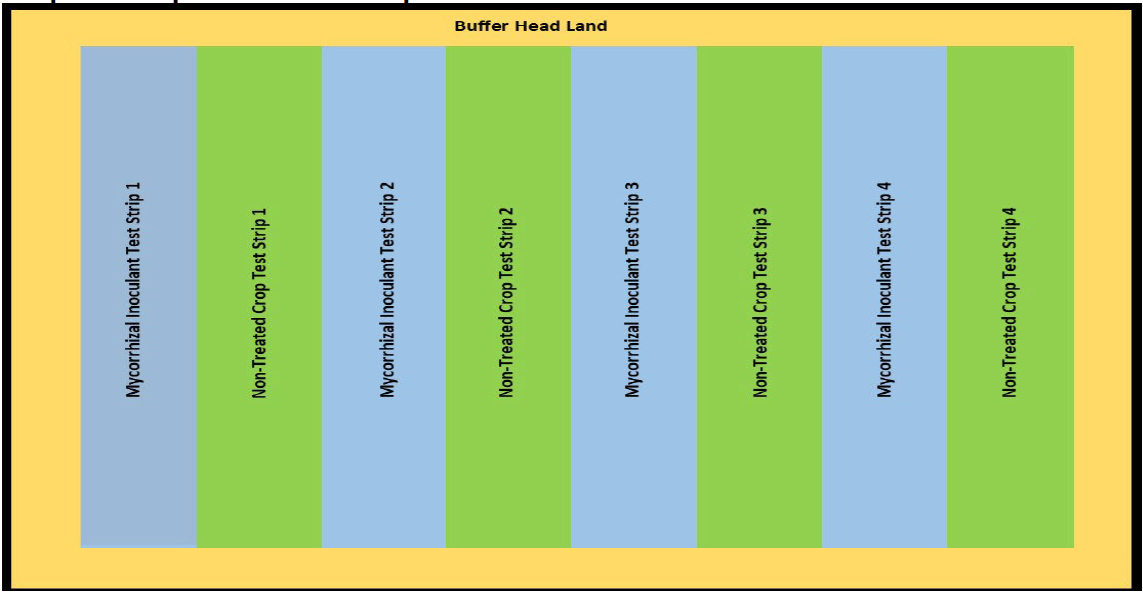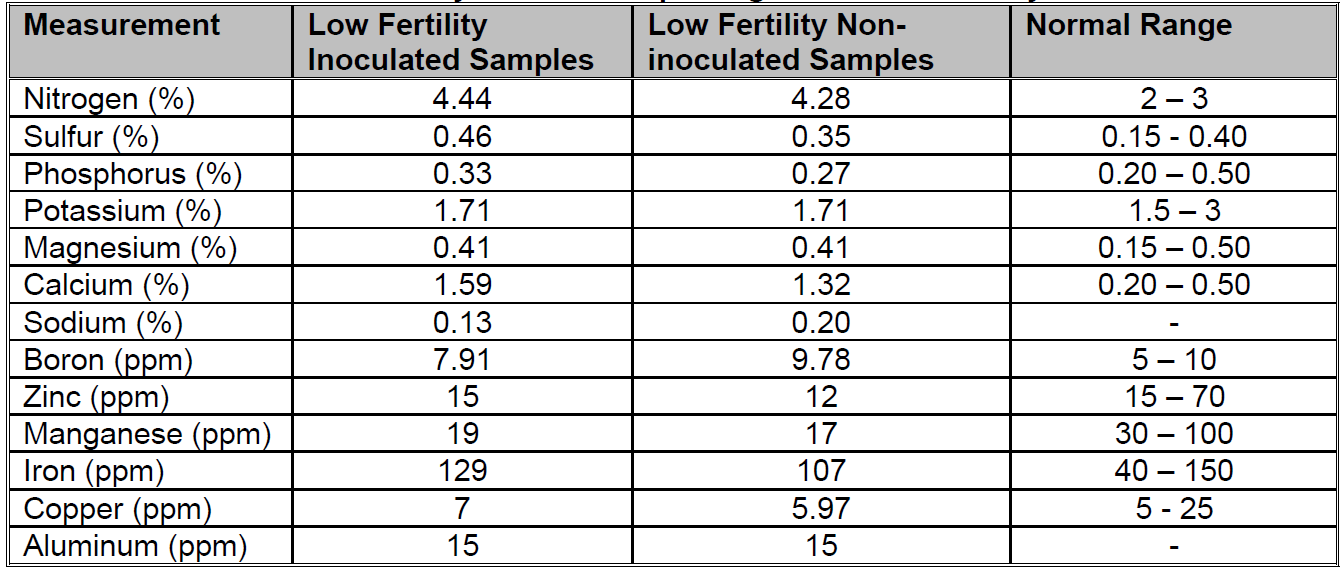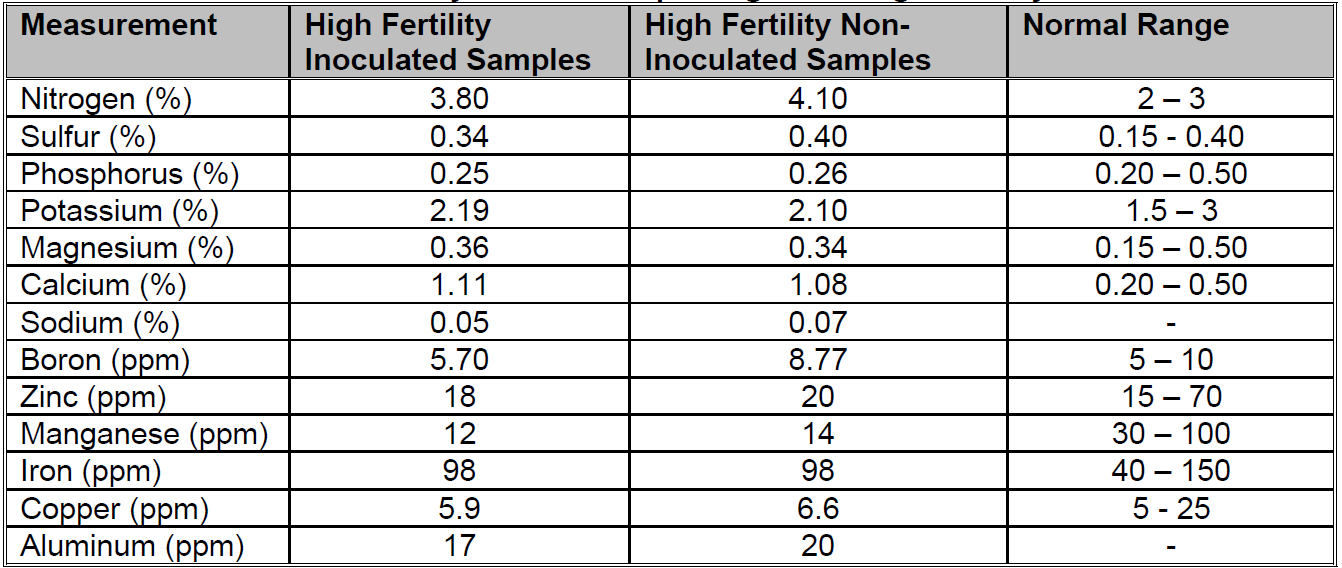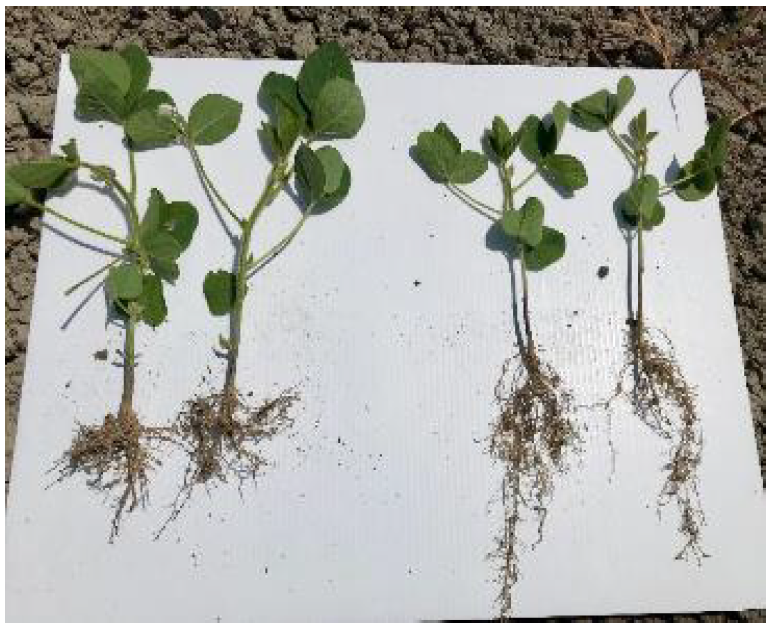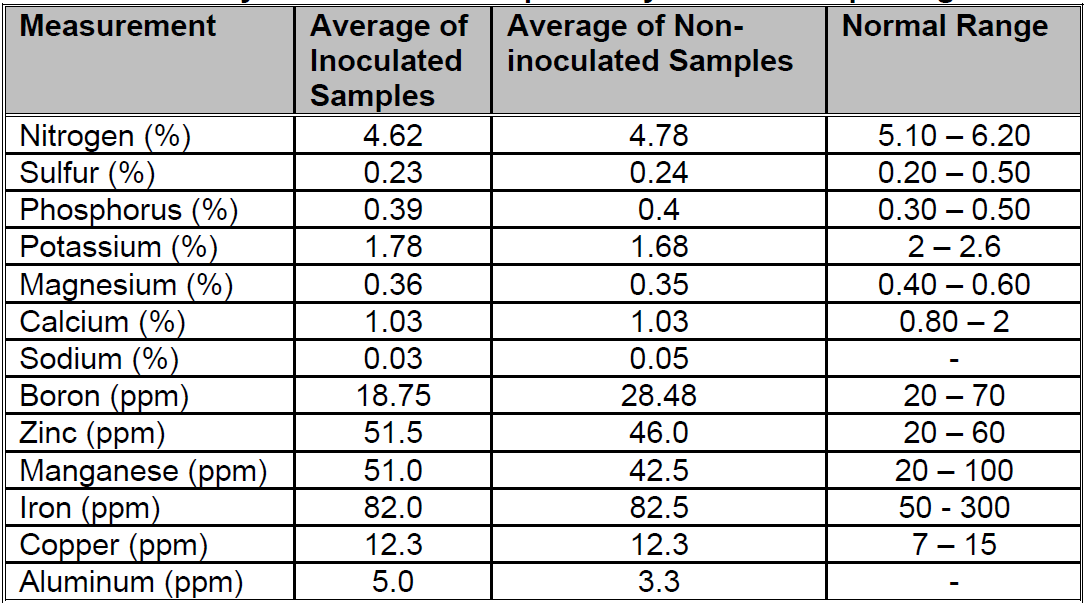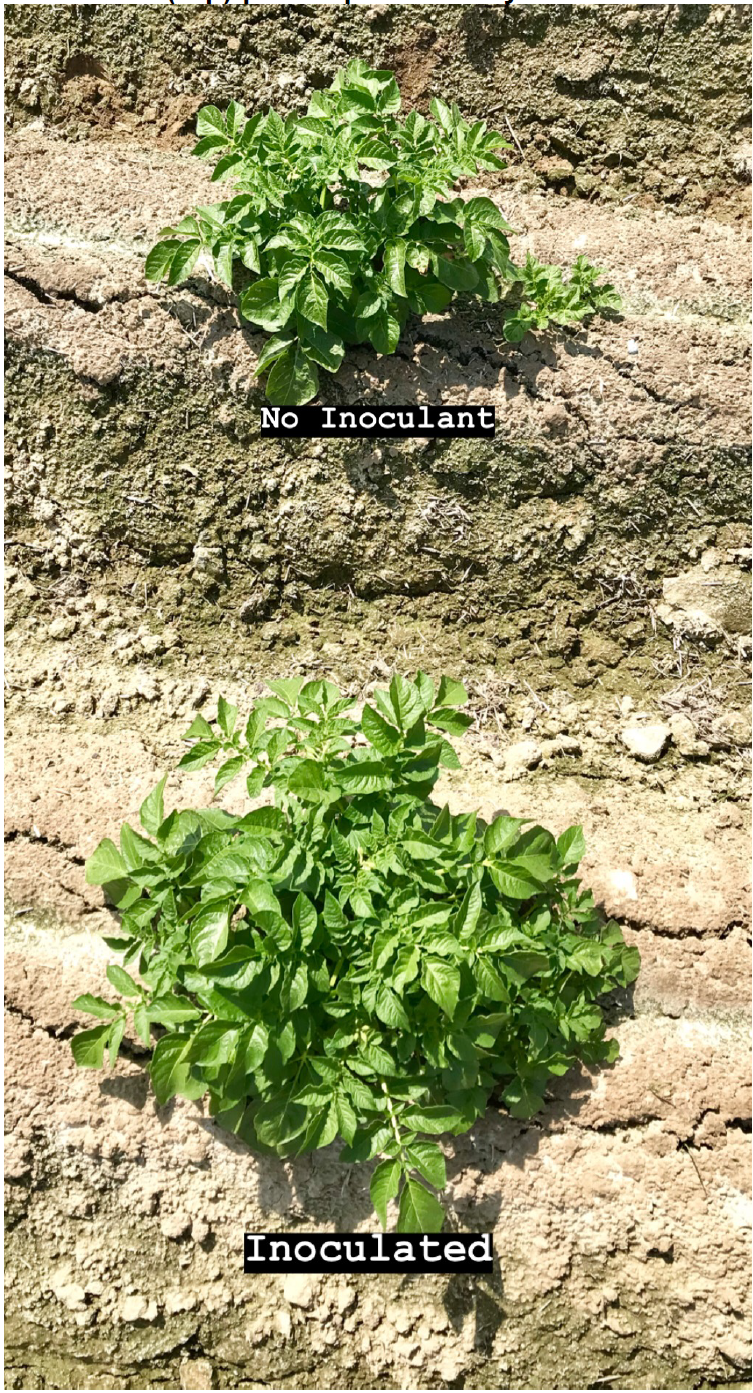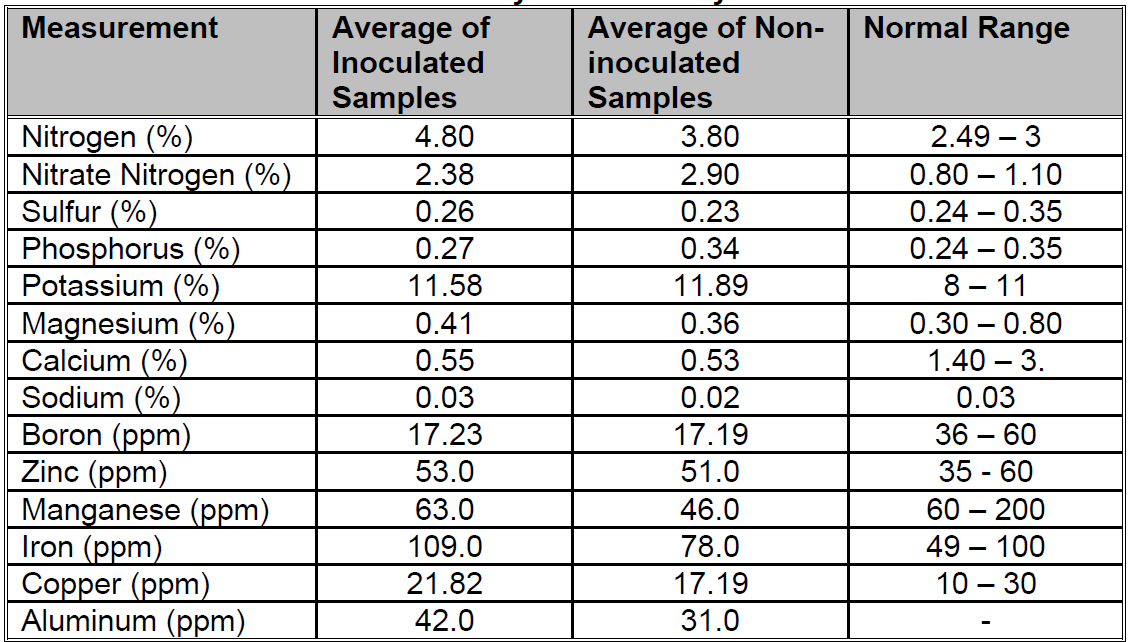Purpose
This project tested the effects of AGTIV mycorrhizal inoculant on potato, cereal and soybean crops. The inoculant is said to improve plant growth, health, and increase overall yield and quality of the crop. With the added fungi in the soil, the mycorrhizal inoculant is also supposed to improve soil health and structure. This trial tested the effectiveness of the inoculant on improving crop production and soil health, with the goal of determining whether the inoculant could improve the quality and yields of crops grown in northern Ontario, therefore benefiting farmers with increased profits from these crops. Long-term benefits could also be provided from improved soil quality, resulting in higher-quality crops in the future.
Background
The Northeastern Ontario Soil and Crop Improvement Association, in partnership with the West Nipissing/East Sudbury and West Sudbury SCIAs and the Northern Ontario Farm Innovation Alliance, conducted a three-year study to test the effects of Premier Tech’s AGTIV mycorrhizal inoculant on potato, soybeans, and oats between 2018 and 2020.
Mycorrhizae are a type of fungi that are found naturally in soils and form mutually beneficial networks with the roots of plants. These networks allow plant roots to reach and uptake minerals, nutrients, and water. As the fungal network expands, the plant has access to minerals, nutrients and water that, through its roots alone, it would not be able to reach. This relationship between plant and fungi stimulates root development and overall plant growth, resulting in healthier and more vigorous plants and therefore greater production and disease resistance. In addition to plant health, mycorrhizae improve soil structure, increase organic matter, and play a positive role in soil aggregation. Soil disturbances, especially frequent deep tilling, break up these fungal networks and reduce their positive effects.
Many trials studying the use of mycorrhizal inoculants on different crops have shown improvements in plant health and yields. Therefore, there is a strong possibility that this product would be a viable option for northern Ontario farmers to help improve crop production.
Premier Tech offers the AGTIV line of biologically active treatments, which, through an inoculant applied at the time of planting, is intended to repopulate and re-establish mycorrhizal networks. The AGTIV line includes treatments optimized for different crops.
This product line is of interest to farmers in the north, and as such, was selected as the mycorrhizal inoculant product to be used over the course of this project.
Methods
Three Premier Tech AGTIV mycorrhizal inoculant products were tested annually on their corresponding crops in four locations in Sudbury and West Nipissing regions between 2018 and 2020. The inoculant products tested were as follows:
- AGTIV Potato Liquid Inoculant
- AGTIV Field Crops Powder Inoculant
- AGTIV Field Crops Liquid Inoculant
- AGTIV Soybean Powder Inoculant
The form of inoculant used (i.e. liquid versus powder) was dictated by the equipment available to the farmers conducting the trials. The trials were conducted on two farms in the Sudbury district area and two farms in West Nipissing area. Each farm conducted trials on 5-acre plots of alternating strips of inoculated and non-inoculated crops. Each farm had two plot sites – one on high fertility soil and one on low fertility soil, selected based on the farmer’s knowledge of their fields. The size and spacing of these strips was determined by each farmer’s equipment, but each plot had at least four strips of both inoculated and non-inoculated crops. Two farms tested the inoculant on potatoes and two farms tested the inoculant on oats and soybeans.
Trials were, where possible, conducted on the same plots each year in order to measure the effect of three consecutive years of mycorrhizal development in the soil. In order to adhere to farmers’ existing crop rotations, the crop grown was changed each year as necessary. In addition to the mycorrhizal inoculant, the crops also received standard fertilizer and pesticide treatments.
During the growth stage of the trials, tissue samples for both inoculated and non-inoculated crops were gathered and analyzed for comparison. Upon harvest, differences in yields between inoculated and non-inoculated strips were recorded and soil samples were taken in both inoculated and non-inoculated plots to gauge the effect of the inoculant on overall soil health. All soil and tissue sample analyses were conducted by A&L Canada Laboratories in London, Ontario. Lab and yield results were interpreted and formatted into field maps by Ben Schapelhouman, CCA-ON of TECC Agriculture Ltd.
Figure 1. Trial plot set-up. At least four reps of inoculated and non-inoculated strips were planted at each plot site over a 5 acre area.
Results
Oats were grown on one farm in 2019 and two farms in 2020.
Table 1. 2019 Oat yields

In 2019, all oat yields together averaged 117.64 bushels per acre. Inoculated plots averaged 118.31 bushels per acre, while non-inoculated plots yielded 116.97 bushels per acre, a difference of 1.34 bushels per acre.
Table 2. 2020 Oat Yields

In 2020, the difference in yield between high and low fertility fields was significant. The average yield for all oats in 2020 was 117.49 bushels per acre. Inoculated plots averaged 117.94 bushels per acre, while non-inoculated plots averaged 117.04 bushels per acre, a difference of .90 bushels per acre.
The oats from West Nipissing Site 1 had poor yields in 2020 due to significant lodging and regrowing. The corresponding yield data was left out of this report. However, prior to these issues, tissue samples were taken and are reported below, followed by tissue samples from West Nipissing Site 2. The purpose of the tissue sample analysis was to determine whether the mycorrhizal inoculant application correlated with increased nutrient and mineral uptake, which would be evident by higher concentrations of nutrients and minerals in the tissue of plants. Increased nutrient and mineral concentrations would be an indicator of the positive effects of the mycorrhizal inoculant, and a sign of healthier, more vigorous, and more disease resistant crops. For oats, samples of the flag leaf at the head emergence from boot stage were gathered in early July 2020.
Table 3. 2020 Oats Tissue Sample Analysis – West Nipissing Site 1
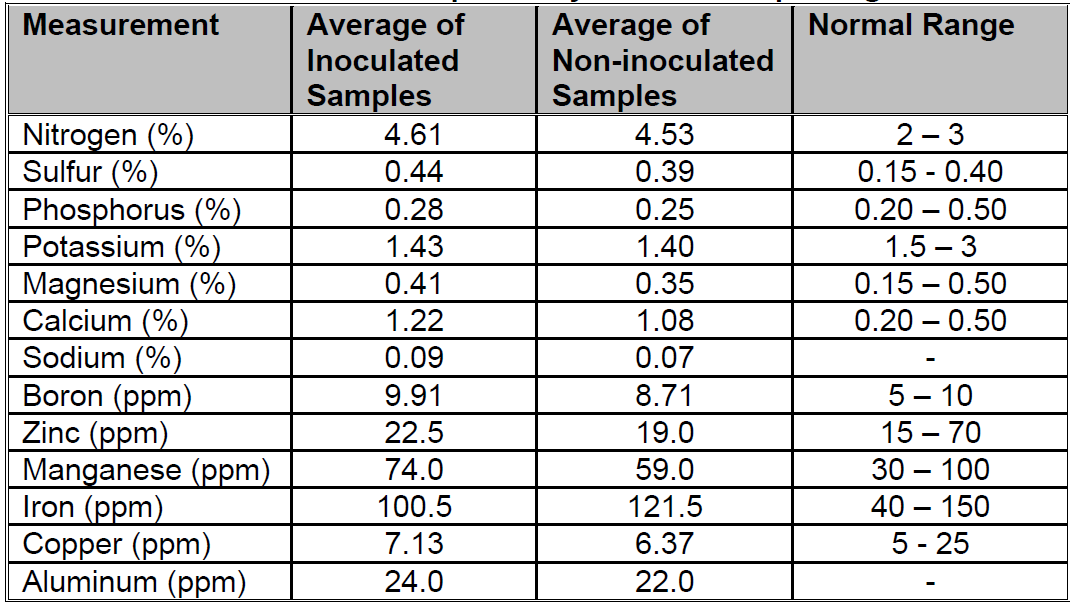
At West Nipissing Site 1, inoculated oat tissue had higher concentrations of all nutrients and minerals than non-inoculated tissue, with the single exception of iron. This suggests the inoculant does improve plant uptake of nutrients and minerals.
At the low fertility field of West Nipissing Site 2, inoculated oat tissue had higher concentrations of nitrogen, sulphur, phosphorus, calcium, zinc, manganese, iron, and copper than non-inoculated samples. Both inoculated and non-inoculated samples had the same potassium, magnesium, and aluminum concentrations, while non-inoculated samples had higher concentrations of sodium and boron than did inoculated samples.
Table 4. 2020 Oats Tissue Analysis – West Nipissing Site 2 Low Fertility Field
One of the most significant differences in nutrient and mineral content between inoculated and non-inoculated crops was seen in oats in the low fertility field at West Nipissing Site 2. This may suggest that the mycorrhizal inoculant is most effective in low fertility fields.
The yield results from that field would seem to agree with that suggestion, as the inoculated oats yielded 85.63 bushels per acre, while the non-inoculated oats yielded 83.94 bushels per acre, a difference of 1.69 bushels per acre. This increase is well above the total average for increased oat yields in this project of 0.92 bushels per acre. However, the soybean results from that same field in the previous year show only a modest increase in yield of 0.15 bushels an acre, so asserting that the inoculant benefits low fertility fields over high fertility fields may not be appropriate.
The least positive tissue sample results came from the high fertility field of West Nipissing Site 2, where non-inoculated oat tissue had higher concentrations of nitrogen, sulphur, phosphorus, sodium, boron, zinc, manganese, copper, and aluminum than inoculated samples. Both inoculated and non-inoculated samples had the same iron concentrations, while inoculated samples had higher concentrations of potassium, magnesium, and calcium.
Table 5. 2020 Oats Tissue Analysis – West Nipissing Site 2 High Fertility Field
Soybeans were grown on two farms in West Nipissing in 2019 and at one farm in West Nipissing in 2020.
Table 6. 2019 Soybean Yields
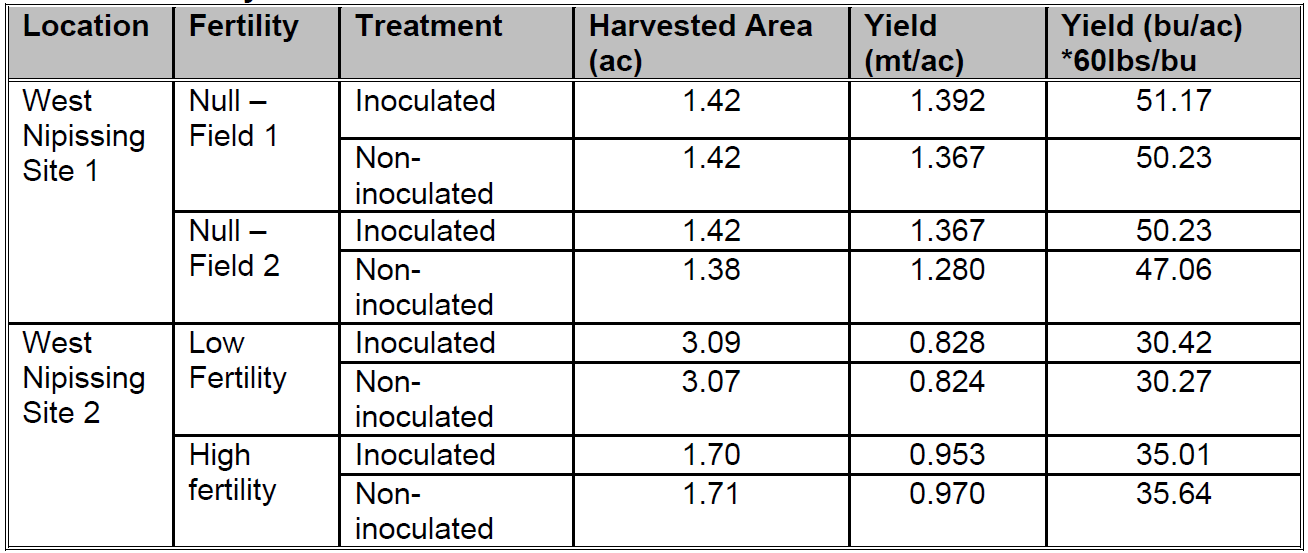
At West Nipissing Site 1, the higher fertility plots had higher measured levels of potassium and organic matter, while the lower fertility plots had lower potassium and phosphorus levels. A site visit on July 9, 2019 showed visible differences in in the root development between the inoculated and non-inoculated soybean plants, as can be seen in figure 2 below.
Figure 2. July 9, 2019 – root comparison of inoculated soybeans (right) versus non-inoculated roots (left).
The 2019 soybean plots were harvested on October 12. Together, all yields averaged 41.25 bushels per acre. Inoculated plots averaged 41.70 bushels per acre, while non-inoculated plots yielded 40.8 bushels per acre, a difference of 0.9 bushels per acre.
Soybean tissue samples were gathered in early July 2020. Samples were taken from recent fully developed leaves at the full bloom stage of growth.
Table 7. 2020 Soybeans Tissue Sample Analysis – West Nipissing Site 1
At West Nipissing Site 1, inoculated soybean tissues had higher concentrations of potassium, magnesium, zinc, manganese, and aluminum than non-inoculated tissue samples. Both inoculated and non-inoculated samples had the same calcium and copper concentrations, while non-inoculated samples had higher concentrations of nitrogen, sulphur, phosphorus, sodium, boron, and iron than did inoculated samples.
Potato plots were grown on two farms in 2019, and on one farm in 2020, all of which were in Sudbury district.
2019 Potato Yields
Due to mechanical issues at harvest, exact yield measurements could not be conducted. However, the farmers estimated an approximately 15 percent greater yield in the inoculated potatoes compared to the non-inoculated potatoes. This would correspond to site visits conducted in July 2019 that showed increased root and foliage development in inoculated versus non-inoculated potato plants.
Figure 3. A comparison of root development in non-inoculated (left) and inoculated potato plants. July 2019.
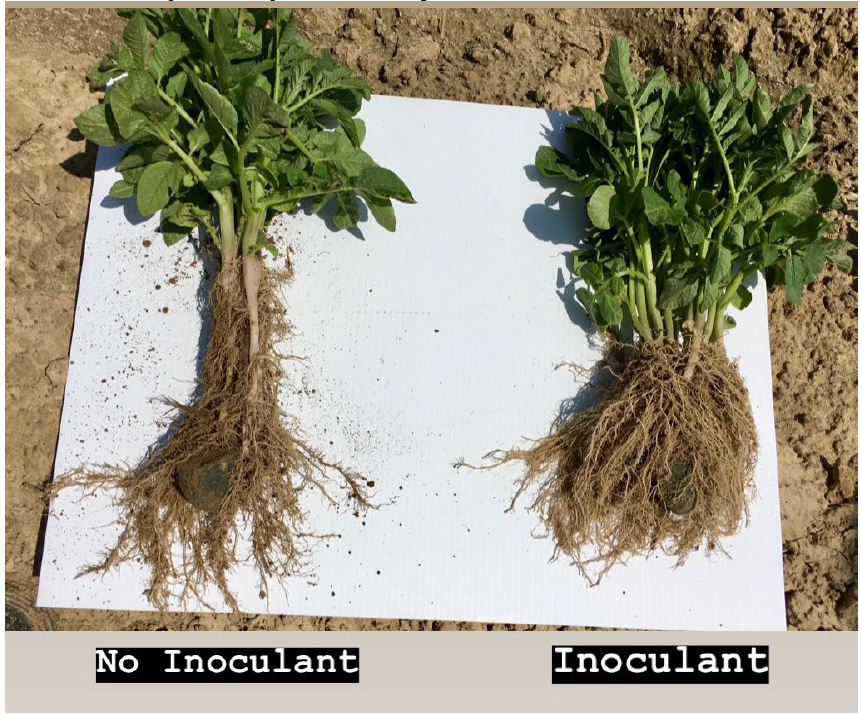
Figure 4. A comparison of foliage development in inoculated (bottom) and non-inoculated (top) potato plants. July 2019.
2020 Potato Yields
In 2020, yield measurements were conducted just prior to harvest at Sudbury Site 1. The field was subdivided into four equal sections lateral to the length of the field. Within these divisions samples of both inoculated and non-inoculated strips were gathered by digging up 1 meter lengths of the potato row, weighing the resulting potatoes, and returning them to the soil for harvest a day or two later. In this way, 48 samples of inoculated potato strips and 48 samples of non-inoculated potatoes were measured, representing samples evenly distributed across the entire field.
The inoculated samples ranged in weight from 4.9 kg/m to 7.4 kg/m, and had an overall average weight of 5.981 kg/m. The non-inoculated samples ranged in weight from 4.0 kg/m to 7.9 kg/m and had an overall average weight of 5.945 kg/m. this represents a yield difference of 0.6%.
Potato tissue samples were gathered 70 days after emergence in mid July 2020. Samples were collected from the fourth petiole from the top of the potato plants.
Table 8. 2020 Potatoes Tissue Analysis – Sudbury Site 1
At Sudbury Site 1, the inoculated potato tissue samples had higher concentrations of nitrogen, sulphur, potassium, magnesium, calcium, sodium, boron, zinc, manganese, iron, copper, and aluminum. Non-inoculated samples had higher concentrations of nitrate nitrogen, phosphorus, and potassium.
Analyses
Yield Analysis
Over the course of the project, all crops showed increased yields which correlated with the application of the mycorrhizal inoculant. Inoculated soybeans, in the two years of data gathered, showed an average increase of 0.825 bushels per acre over non-inoculated soybeans. Inoculated oats showed an average increased yield of 0.92 bushels per acre over non-inoculated oats. Potato yields are harder to quantify due to the combination of qualitative and quantitative data. In 2019, farmers reported an estimated 15% increase in yield in inoculated potatoes over non-inoculated potatoes. In 2020, the yield sampling showed a more modest increase of 0.6% in inoculated over non-inoculated potatoes.
Economic Analysis
Table 9. A Comparison of Increased Income and Cost of Inoculant Application

The AGTIV field crops powder inoculant product, which was used for oats, costs $478 for a 2kg bucket, which covers 40 acres. The AGTIV field crops liquid inoculant costs $239 for a 950ml bottle, which covers 20 acres. Both products come out to an approximate application cost of $11.95 per acre. Given an oats price of $4.60 per bushel (approximate price of January 2021) the inoculant correlates with an average increase in income of $4.23 (0.92 bushels) per acre, which, subtracted from the $11.95 per acre application cost, results in a net decrease in income of $7.63 per acre.
The AGTIV soybean powder inoculant product costs $560 for 4.7kg bucket, which covers 40 acres. This results in an approximate cost of $14 per acre to inoculate. Given a soybean price of $14 per bushel (approximate price of January 2021), the inoculant correlates with an average increase in income of $11.55 (0.825 bushels) per acre, which, subtracted from the $14 per acre application cost, results in a net decrease in income of $2.45 per acre.
The AGTIV potato liquid inoculant product costs $550 for a 950ml bottle, which covers 10 acres. This results in an approximate application cost of $55 per acre. Potatoes are priced per hundredweight (cwt), or 100lbs. OMAFRA lists the 2018 (the latest year of data available) average potato yield to be 205 cwt per acre. At a price of $25.25 per cwt (approximate price of January 2021) average income for an acre of potatoes would be $5176.25. In 2019 inoculated potato yields were estimated at 15% more than non-inoculated potatoes, while 2020 yield sampling showed a difference of 0.6% in inoculated over non-inoculated potato yields. Applying the 15% yield increase estimate to the $5176.25/acre numbers would mean inoculation results in an increase in income of approximately $776.43 per acre. Applying the 0.6% yield increase measurement to the $5681.25/acre numbers would mean inoculation results in an increase in income of approximately $31.05. Given the $55 per acre application cost of the inoculant, the 15% estimate would result in a net increase in income of $721.43 per acre, while the 0.6% measurement would result in a net decrease in income of $23.95 per acre.
This economic analysis takes onto account only the application cost of the inoculant and the correlated increased yield. It does not account for other potentially positive outcomes from the inoculant, such as more disease resistant plants and better uptake of soil nutrients. For example, it would not take into account the potential saved cost of additional spraying for a deficiency that these crops did not have because they received the inoculant.
Summary & Next Steps
Over the course of the project, all crops showed increased yields which correlated with the application of the mycorrhizal inoculant.
Similar to the modest increases in yield seen in the trial, the inoculant appears to improve plant health at the individual level, as evidenced by the tissue analyses conducted. Five tissue sample analyses were conducted: West Nipissing Site 1 soybeans, West Nipissing Site 1 oats, West Nipissing Site 2 high fertility and low fertility oats, and Sudbury Site 1 potatoes.
In total, nutrients and minerals were compared between inoculated and non-inoculated tissue samples 66 times. The inoculated tissues had higher nutrient and mineral concentrations in 39 of those cases, inoculated and non-inoculated tissue had the same concentrations 6 times, and non-inoculated tissues had higher concentrations 21 in of those cases. Inoculated plants regularly had significantly higher concentrations of nutrients and minerals than non-inoculated plants, and only rarely had significantly lower concentrations. This suggests that the mycorrhizal inoculant does allow plants to become more healthy and vigorous.
In summary, the results of this project suggest that, while the mycorrhizal inoculant application does correlate with improved plant health and yield, that increased yield does not, on average, outweigh the cost of the inoculant application in the first place.
This report will be made available on FarmNorth.com and nofia-agri.com. A factsheet will also be made available in Winter 2021. Currently, further study of biostimulants and mycorrhizal inoculants is being explored in partnership with Algoma University and the University of Guelph. This potential study will build on the findings from this project and will further explore the viability and application of these products in northern climates.
References
Hijri, M. 2016. Analysis of a large dataset of mycorrhiza inoculation field trials on potato shows highly significant increases in yield. Mycorrhiza 26, 209–214 (2016). https://doi.org/10.1007/s00572-015-0661-4
Douds Jr., D.D., Nagahashi, G., Reider, C., and Hepperly, P.R. 2007. Inoculation with Arbuscular Mycorrhizal Fungi Increases the Yield of Potatoes in a High P Soil, Biological Agriculture & Horticulture, 25:1, 67-78, DOI: 10.1080/01448765.2007.10823209
Acknowledgements
A huge thank you to our farm co-operators, Valley Growers for their industry expertise, Collège Boréal for their project support, TECC Agriculture for their agronomical support, Northeastern Ontario Soil and Crop Improvement Association and the local associations for their project and communications support, and the Northern Ontario Farm Innovation Alliance for collaborating the project.
Project Contacts
Emily Potter, Executive Director, NOFIA, emily.nofia@gmail.com
Alex McRae, President, Northeastern Ontario SCIA, gawasfarm@gmail.com

